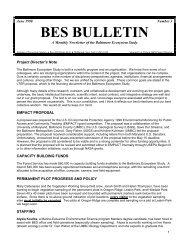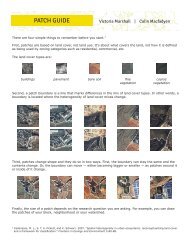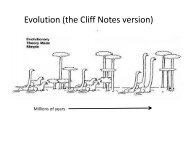Investigations in Urban Soils - Baltimore Ecosystem Study
Investigations in Urban Soils - Baltimore Ecosystem Study
Investigations in Urban Soils - Baltimore Ecosystem Study
Create successful ePaper yourself
Turn your PDF publications into a flip-book with our unique Google optimized e-Paper software.
Draft 2 - (9.28.04)<br />
<strong>Soils</strong> <strong>Urban</strong> <strong>in</strong> <strong>Investigations</strong><br />
The soil mosaic <strong>in</strong> urban areas represents a hodge-podge of soil conditions due to<br />
human activity, the emplacement of <strong>in</strong>frastructure (e.g., sewers), and what rema<strong>in</strong>s of<br />
the orig<strong>in</strong>al landscape.<br />
Is There a Typical <strong>Urban</strong> Soil?<br />
Results of our research <strong>in</strong> <strong>Baltimore</strong> and elsewhere (most notably New York City)<br />
suggest that characteristics of soils can vary widely <strong>in</strong> urban landscapes, mak<strong>in</strong>g it<br />
difficult to def<strong>in</strong>e or describe a typical “urban soil.” Physical properties and pH <strong>in</strong> urban<br />
soil are more consistent from place to place than are chemical properties. Despite the<br />
high amount of variation, consistent differences <strong>in</strong> soil P, K, bulk density (the weight of<br />
soil per unit volume – an <strong>in</strong>dicator of compaction), Ca, and pH related to land use. For<br />
example, forest soils <strong>in</strong> cities were very different from high-density residential soils. In<br />
fact, the clearest differences between forests and lawns were <strong>in</strong> P and K levels. It just<br />
so happens that these nutrient elements are a major component of most lawn fertilizers,<br />
possibly expla<strong>in</strong><strong>in</strong>g these differences. Soil pH levels varied among lawn, possibly<br />
reflect<strong>in</strong>g differences <strong>in</strong> how much lime or other amendments people use on their lawns.<br />
<strong>Urban</strong> <strong>Soils</strong> <strong>in</strong> <strong>Baltimore</strong><br />
<strong>Baltimore</strong> lies along the Chesapeake Bay between two physiographic<br />
prov<strong>in</strong>ces: the Piedmont Plateau and the Atlantic Coastal Pla<strong>in</strong>. The northnortheast<br />
trend<strong>in</strong>g Fall L<strong>in</strong>e separates the two prov<strong>in</strong>ces, divid<strong>in</strong>g the city<br />
approximately <strong>in</strong> half (Fig. 1). Most of the city is characterized by nearly level to gently<br />
roll<strong>in</strong>g hills, dissected by narrow stream valleys. The Piedmont Plateau <strong>in</strong> the city is<br />
underla<strong>in</strong> by amphibolite, mafic, and ultramafic rock types, characterized by relatively<br />
large concentrations of iron and magnesium which contribute to the rocks’ characteristic<br />
dark color (U.S. Geological Survey map of <strong>Baltimore</strong>’s west quadrangle, 1979). The<br />
Coastal Pla<strong>in</strong> <strong>in</strong> the city is underla<strong>in</strong> by much younger, poorly consolidated sediments<br />
such as gravel and sand. <strong>Soils</strong> <strong>in</strong> the Piedmont Plateau of <strong>Baltimore</strong> are very deep,<br />
nearly level to moderately slop<strong>in</strong>g, and well-dra<strong>in</strong>ed, and are underla<strong>in</strong> by semi-basic or<br />
mixed basic and acidic rocks. <strong>Soils</strong> <strong>in</strong> the Coastal Pla<strong>in</strong> of the city are very deep,<br />
somewhat excessively dra<strong>in</strong>ed and well-dra<strong>in</strong>ed upland soils that are underla<strong>in</strong> either by<br />
sandy or gravelly sediments or by unstable clayey sediment (NRCS, 1998). Highly<br />
disturbed soils make up more than 60% of the land area of the city (Pouyat et al., 2001).<br />
<strong>Soils</strong> <strong>in</strong> the coastal pla<strong>in</strong> parts of <strong>Baltimore</strong>, formed over the mafic or ultramafic<br />
bedrock, have high levels of some metals (Al, Mg, V, Mn, Fe, Ni) that have important<br />
ecological consequence. The fact that natural soil-form<strong>in</strong>g factors, <strong>in</strong> this case<br />
weather<strong>in</strong>g of parent material, has such a clear effect on the current soil despite the<br />
large amounts of development and disturbance to these soils is very surpris<strong>in</strong>g. Unlike<br />
soil properties related to lawn management; heavy metal contents did not differ among<br />
land-uses, suggest<strong>in</strong>g that these elements are related to factors such as the history of<br />
the site and how close the site is to contam<strong>in</strong>ant sources such as a major road (Fig. ?).<br />
page 8<br />
<strong>Baltimore</strong> <strong>Ecosystem</strong> <strong>Study</strong><br />
– <strong>Investigations</strong> <strong>in</strong> <strong>Urban</strong> <strong>Soils</strong>






